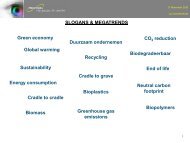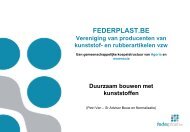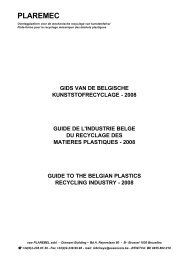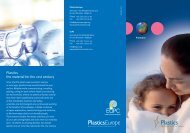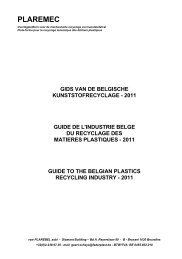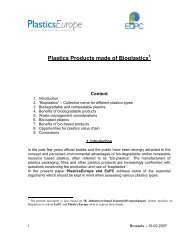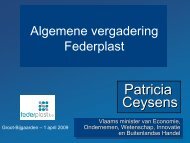Prof. Filip Du Prez - Federplast.be
Prof. Filip Du Prez - Federplast.be
Prof. Filip Du Prez - Federplast.be
You also want an ePaper? Increase the reach of your titles
YUMPU automatically turns print PDFs into web optimized ePapers that Google loves.
Innovatie in kunststoffen<br />
voor duurzaamheid<br />
<strong>Filip</strong> <strong>Du</strong> <strong>Prez</strong><br />
Polymer Chemistry Research Group<br />
Ghent University, Belgium<br />
www.PCR.UGent.<strong>be</strong><br />
Workshop innovatie in kunststoffen – novem<strong>be</strong>r 2010<br />
0
1<br />
Polymer Science<br />
& Technology<br />
Research Entity<br />
www.polymer.ugent.<strong>be</strong>
2<br />
U<br />
PBM -Gent<br />
Polymer Chemistry & Biomaterials Group<br />
Polymer<br />
Science<br />
& Technology<br />
www.polymer.ugent.<strong>be</strong><br />
9 onderzoeksteams<br />
> 60 researchers<br />
Valorisation consortium
• Patent portfolio<br />
• Industrial collaborations<br />
• Spin-off opportunities<br />
Sam Verbrugghe, PhD<br />
AUGent Technology Coordination<br />
ChemTech Division<br />
+ Technology development<br />
+ Application development
4<br />
Innovatie in kunststoffen: Quo vadis?
5<br />
Wat zijn biopolymeren ?<br />
Bio-gebaseerd Bio-degradeerbaar
6<br />
Wat zijn biodegradeerbare polymeren?<br />
Populaire definitie:<br />
« Biodegradable is said for an industrial product that,<br />
when discarded, is destroyed by bacteria and other<br />
biological agents »<br />
Definitie houdt geen rekening met:<br />
- Plaats waar biodegradatie optreedt (grond, water, composthoop, …)<br />
- Compositie en vorm van materialen; degradatietijd<br />
- Biodegradatie testmethoden<br />
- Uiteindelijke milieu-impact<br />
Meer dan 15 jaar zijn nodig geweest om tot een consensus te komen…
7<br />
Wat zijn biodegradeerbare polymeren?<br />
« Environmentally Degradable Plastics ‘EDPs’<br />
worden gedefinieerd als polymeermateriaal-gebaseerde<br />
producten die:<br />
Zelfde performantie <strong>be</strong>houden als gebruikelijke plastics gedurende hun gebruik;<br />
Na gebruik degraderen in laag moleculair gewicht componenten door gebruik van<br />
biologische stimuli en/of chemisch/fysische stimuli (licht, water, zuurstof,…) in de<br />
omgeving;<br />
Uiteindelijk degraderen in CO 2 en/of CH 4, H 2O, en biomassa aan vergelijkbare<br />
snelheden en conversies zoals bij andere degradeerbare materialen en die geen<br />
permanente of toxische residuen achterlaten»<br />
Uit: - American Society of Testing and Materials (ASTM),<br />
- International Standard Organization (ISO)<br />
- Comité Européen de Normalisation (CEN)<br />
(AIM Magazine, Vol. 55, suppl. 1, 2001, p. 66- 71)
Levenscyclus biodegradeerbare polymeren<br />
8
9<br />
Klassificatie biodegradeerbare polymeren?<br />
Biomass products<br />
From agro-resoures<br />
Agro-polymers<br />
Polysaccharides Proteins,<br />
Lipids<br />
Starches<br />
Wheat<br />
Potatoes<br />
Maize,…..<br />
Ligno-cellulosic<br />
products:<br />
Wood<br />
Straws,.....<br />
Others:<br />
Pectins<br />
Chitosan/Chitin<br />
Gums,….....<br />
Animals:<br />
Casein<br />
Whey<br />
Collagen/Gelatin<br />
Plant :<br />
Zein<br />
Soya<br />
Glutten<br />
Biodegradeerbare polymeren<br />
From micro-organisms<br />
(obtained by extractions)<br />
Polyhydroxyalkanoates<br />
(PHA)<br />
Poly(hydroxybutyrate) (PHB)<br />
Poly(hydroxybutyrate<br />
co-hydroxyvalerate) (PHBV)<br />
From biotechnology<br />
(conventional synthesis<br />
from bio-derived monomers)<br />
Polylactides<br />
Poly(lactic acid)<br />
(PLA)<br />
Ref: Progress in Polymer Science, 34, 125-155 (2009)<br />
From petrochemical<br />
products<br />
(conventional synthesis<br />
from synthetic monomers)<br />
Polycaprolactones<br />
(PCL)<br />
Polyesteramides<br />
(PEA)<br />
Aliphatic<br />
co-polyesters<br />
(e.g. PBSA)<br />
Aromatic<br />
co-polyesters<br />
(e.g. PBAT)
10<br />
Productiecapaciteit: 0.5% van alle kunststoffen<br />
1.5 miljoen ton<br />
bioplastics<br />
300 miljoen ton<br />
synthetische polymeren
11<br />
Composteerbaar vs niet-composteerbaar<br />
http://www.european-bioplastics.org/
12<br />
Waarvoor zoal gebruikt ?<br />
fi<strong>be</strong>rs<br />
23%<br />
others<br />
7%<br />
packaging<br />
70%
Bio-polymeren: impact op voedselketen ?<br />
13<br />
Is het rationeel landbouwgronden te gebruiken voor de<br />
productie van bio-polymeren?<br />
“Recently the impact of bioplastics has <strong>be</strong>en about 250<br />
times lower than the impact of biofuels, hence lower than<br />
0,1%. Therefore, the impact of bioplastics on the world<br />
food market is negligible. Additionally, producing biofuels<br />
or bioplastics means in most cases also producing high<br />
value protein-rich by-products that can <strong>be</strong> used as animal<br />
feed.”<br />
Bioplastics Magazine<br />
(04/2009)
14<br />
Voor<strong>be</strong>eld van eigen innovatie-bijdrage<br />
Ontwerp van biodegradeerbare, alifatische polyesters<br />
met op-maat-gemaakte eigenschappen…<br />
More info: Feature article in Polymer, 50, 3877-3886 (2009)
15<br />
Biopolymeren : de toekomst ?<br />
Biodegradeerbare en/of biogebaseerde polymeren<br />
zullen de energie- en klimaatproblemen niet oplossen …<br />
Maar, indien op de juiste manier aangewend, kunnen ze<br />
bijdragen tot de oplossing.
16<br />
Andere opties naar duurzame kunststoffen…<br />
Eén voor<strong>be</strong>eld: sterke verhoging levensduur via zelfhelende kunststoffen:<br />
Commercieel zelf-helend materiaal gebaseerd op<br />
supramoleculaire systemen (2009, Arkema, Reverlink TM )



